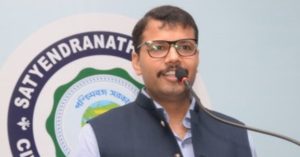Amid Second Wave, How An IPS Officer Ensured 0 Deaths Among 1000 SRPF Personnel
Harssh Poddar, commanding officer of the State Reserve Police Force (SRPF) in Amravati, undertook a series of measures to keep over 1,000 personnel and 3000 family members safe amid the second wave of coronavirus

In February 2021, when many parts of the country were returning to some form of normalcy amid COVID-19, the situation in rural parts of Amravati in Maharashtra had started turning grim again. The new delta variant of the coronavirus emerged from this city, thus unleashing the massive second wave.
This spike in cases worried Harssh Poddar, commanding officer of the State Reserve Police Force (SRPF), Amravati. “We were the first to feel the heat of the second wave. There were over 1,000 personnel to take care of inside the 30-acre campus. Moreover, they were preparing to travel to three other states for their election duty. They needed to travel by bus, railways and other public transport for the task. Also, around 3,000 family members lived with them in the same house,” Harssh says.
Explaining the gravity of the situation to The Better India, he adds, “These 4,000 people were at high risk as they live in confined spaces. Most of the personnel live in a one-bedroom house with a kitchen and living room. If the infection spread, it could have been catastrophic.”
However, the IPS officer has demonstrated how meticulous planning, taking articulate measures, and timely intervention can save crucial lives in a pandemic. Harssh undertook several efforts to achieve zero fatality among his personnel and did not allow the infected patients to turn critical. During the second wave, only 118 officials tested positive for COVID-19, and there were not more than 25 patients at any given time.
Harssh talks about how he achieved this feat.
Tackling vaccine hesitancy
“The first step was to begin vaccination drives for the staff. There was high vaccine hesitancy when the second wave started peaking. Hence, we conducted multiple counselling sessions with doctors and ensured that 100% personnel were vaccinated,” he says, adding that the drive was later extended for 1,500 family members who were eligible.
The administration also set up two isolation centres to prevent the risk of spread of the infection.
Harssh says the second step included taking prudent actions on the patients testing positive. “A lot of reports were emerging about patients collapsing in a matter of hours and dying. We identified the most common symptoms in the patients, which indicate the deteriorating health. These included blood coagulation, multiple organ failure, pneumonia and cytokine storm,” he says.
He adds, “We identified three tests, namely, the D-Dimer that helps determine blood clots. The other was the Interleukin IL-6, which helps monitor inflammations such as infection, rheumatoid arthritis, identify diabetes, and cardiovascular disease. The third was the liver and kidney test.”
Harssh says that the tests were conducted on the patients whose health was flagged as a concern by doctors, or subject to worsening. “The tests helped us diagnose the issue and provide timely medical treatment,” he adds.
He also made necessary arrangements in anticipation of shortage of oxygen “As a temporary measure, we arranged two oxygen concentrators for patients experiencing breathlessness. These supported the patients until they reached the hospital for better treatment with stable oxygen supply,” he says.
Saving precious lives
Shailesh Pusadkar, an officer stationed at Amravati, says, “There were strict measures in place to ensure that the patient was immediately quarantined, which stopped further spread of infection. Additionally, the protocol in place and tests conducted guaranteed that the health of the patients did not deteriorate.”
Harssh says that steps undertaken helped prevent panic as well as loss of precious lives. “At present, about 88% of the personnel have completed their second dose of vaccination too. It is unimaginable to think how the scenario would unfold if the strategic planning was not put in place,” he says.
Edited by Divya Sethu
This story made me
- 97
- 121
- 89
- 167
Tell Us More
We bring stories straight from the heart of India, to inspire millions and create a wave of impact. Our positive movement is growing bigger everyday, and we would love for you to join it.
Please contribute whatever you can, every little penny helps our team in bringing you more stories that support dreams and spread hope.



















